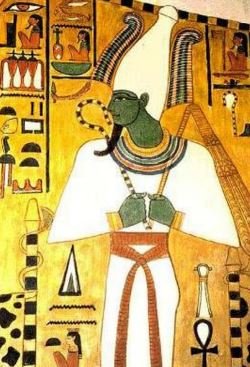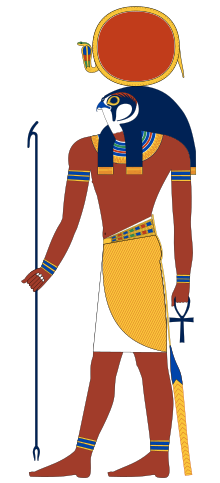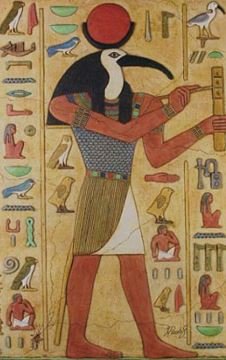10 Most Revered Gods and Goddesses in Ancient Egypt
The ancient people of Egypt were very religious and superstitious. They worshiped gods and goddesses that mainly represented natural forces like rain, the sun, the moon, etc. The worship of these deities formed a very important part of their lives. They often appeased their gods and goddesses by offering sacrifices and performing rituals. Below are 10 most revered gods and goddesses in ancient Egypt:
Osiris, god of the underworld

Osiris- the Egyptian god of the underworld
Ancient Egyptians were firm believers in life after death. Osiris was a god responsible for taking care of the departed souls in the next world. According to Egyptian myths, Osiris was a ruler who incurred the wrath of Seth (his brother) for marrying the beautiful goddesses Isis. The story goes on to say that Osiris had a brief affair with Seth’s wife, Nephthys. The result of this illicit affair brought forth Anubis, the god of funerals and embalming.
Enraged and jealous, Seth killed Osiris and cut his body into pieces. Osiris’s dismembered body was then scattered across the earth.
Isis (Osiris’s wife and sister) could not watch her husband go away. With the help of Osiris’ son Anubis, Isis was able to assemble the dismembered body of Osiris and breathed life (mummify) into him again. The resurrected Osiris then fathered a son with Isis; the son was named Horus, the Egyptian falcon god of the sun.
More:
Symbolically, Osiris is identified as a green-skinned king who wields a staff and wears wrappings. He is depicted in green because of the mummification that was done on him by Isis and Anubis. The Egyptians would later go on to mummify their kings and loved ones in order to usher them properly into the afterlife.
Osiris had a large cult following all over Egypt, particularly in the ancient city of Abydos. Legend has it that he was instrumental in bringing the ancient Egyptians out of the dark by halting barbaric practices of cannibalism. Osiris also bestowed on them techniques in hunting, fishing, farming, and irrigation.
The goddess Isis

Isis- goddess of femininity and marriage
As mentioned above, Isis was both the wife and sister of the lord of the underworld, Osiris. Isis slowly gained significance in Egyptian myths despite the fact that ancient literature failed to cover her virtues as a caring mother.
Aside from her miraculous resurrection of Osiris, she also takes credit as the goddess of marriage, security, health, and magic. Her connection with the god of the underworld (Osiris) also puts her on duty as one who is a mourner and mother of the dead. Isis is more like an Egyptian equivalent Greek goddess to Aphrodite – the Greek goddess that controls affection and splendor.
Amun, the father of all Egyptian gods

Amun- the supreme god of Egypt
Egyptians rate Amun as the equivalent to Roman god Jupiter and the Greek god Zeus. Amun was the supreme ruler of all Egyptian gods; he was the king of all deities in the Egyptian pantheon. The female alternative god of Amun is called Amunet.
Ancient Egyptians believed that Amun was the forefather of their pharaohs. He was the patron god of the city of Thebes – the ancient Egyptian capital situated along Nile River. Amun’s name was suffixed with Ra (the creator god of the sun). This combination brought forth Amun-Ra (sometimes called Atum-Ra).
Amun-Ra, sometimes described as the “Hidden One”, was even worshiped beyond the borders of Egypt and across the Mediterranean.
Anubis, the jackal god

Anubis- the god of embalming and funerals
The god Anubis is usually identified as the god of the deceased, funerals, grief and embalming. He was in charge of the afterlife before Osiris succeeded him. He was often considered a psychopomp, meaning that he was the spirit that guided departed souls into the afterlife. Anubis also preserved dead bodies by a process called mummification. The first deceased body Anubis embalmed was Osiris’s. Anubis even helped Isis to bring Osiris back to life.
The ancient Egyptian portrayed Anubis as a dark in complexion. Black things in ancient Egypt signified the rich deposits of the Nile River which made farming a success. Anubis has a human body and the head of a jackal – a wild animal which closely resembles a dog.
Horus, the falcon god of the sky

The sun god Horus
Horus was the son of Osiris. His father’s prominence among Egyptian gods secured him a frontline position in godly myths. He ruled over the skies; he protected people and helped them by granting them winning battle strategy. It was also believed that Horus revenged his father’s death and then reigned over Egypt for years.
Pictorially, Horus is shown as a falcon-headed man who wears a red crown. Horus’s eye is known as Wedjat which is similar to that of Ra (i.e. the Eye of Ra). The eye signifies that everything is guarded under the skies and that nothing escapes the gaze of Horus. According to the Osiris Myths, when he fought Seth, his left eye got lost. It was the god Thoth who restored his sight.
Ra, the sun god

Ra, the Sun God
Egyptian god Ra was venerated as the god of the sun, maker of the universe and controller of it. Pictorially, he is thought to have a human body with the head of a hawk. Ra is sometimes spelled Re; both refer to the Egyptian Sun god.
Ra is also the alpha and omega in ancient Egyptian religion. As king of the gods of Egypt, Ra is regarded as the creator of everything in the universe.
Some myths state that Ra used a boat to move in the sky daily. He also traveled to the underworld nightly. During his nightly voyages to the underworld, he fought the god of the snakes (Apopis) before he could re-rise. The disk of the sun is often shown above his head.
Thoth, god of wisdom and knowledge

Thoth, the god of knowledge and wisdom
Thoth was an Egyptian god who acted as a conflict resolver; he stepped in to settle misunderstandings between forces of darkness and light (good and evil). He was also considered the god of reading, writing, and wisdom.
No other Egyptian deity had secrets and discerning knowledge like Thoth. Egyptians considered him as the god who introduced hieroglyphics (picture writing) to the world.
Thoth’s duty as a god goes beyond his reasoning abilities; he is also associated with letters of languages and the moon. Egyptians even recognized him as a scientific and philosophical author. Thoth is represented by a baboon or a man with an ibis’ head.
Geb, god of the earth

Geb is also known as god of the Earth or father of serpents (snakes). He was the supplier of crops and the god of healing. With a goose seated on his head, Geb was a bearded god who could invoke earthquakes.
The god Geb was such a powerful being that he could use laughter to trigger quakes. He plays leading roles in the judgment of the dead; the people of Egypt had a belief that Geb was the one who took charge of all wicked souls. He is believed to have taken his sister – the goddess Nut – as his wife. The two deities gave birth to five very revered deities – Osiris, Isis, Seth , Nephthys , and Horus the Elder.
Seth, the god of chaos and destruction

Seth, the desert god of chaos
Seth (Set) was a troublesome god; he was considered the god of chaos, disorder, violence, strong winds, and the wilderness. According to popular Egyptians myths, Seth was the one who killed Osiris. Some variant myths about Osiris say that Seth offered Osiris a casket and later deceived Osiris to lie in the casket. He then closed the casket and dumped it in the Nile. However, and to his dismay, Osiris did stay dead for a long time. Isis came to the help of Osiris and resurrected him.
Egyptian historians have been unsure of how to properly depict Seth. He is commonly shown as a man with an animal head. The kind of animal hasn’t been figured out yet. His head is portrayed as having a long nose and square-tipped ears. His animal stature has dazzled mythologists for centuries now. Many people have concluded that such kind of animal simply doesn’t exist.
The goddess Hathor

Hathor was an ancient Egyptian goddess who was designated as the giver of children. It was believed that she helped women to have safe delivery. Part of her responsibilities also included love. As a result of this, Hathor was associated with Greek goddess Aphrodite.
Goddess Hathor is mostly depicted as a cow or a cow-headed woman. Her funeral responsibilities included work as “Lady of the west”. Graves were dug along the western banks of the Nile River in her honor. Her job was welcoming of the dead into the next life. Hathor was also worshiped by the Egyptians as the goddess of music and dance.



























